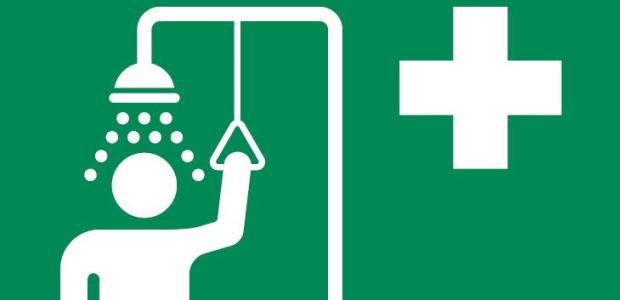
All-Important Equipment When Seconds Count
Placement of the emergency equipment is very important. A person in pain and with possibly obstructed vision should be able to traverse the path from hazard to the flushing units within seconds.
- By Jerry Laws
- Jul 01, 2017
We've all read the statistic that tells us about 2,000 workers in the United States suffer eye injuries requiring medical treatment every day. It's usually attributed to NIOSH and followed or preceded by the admonition that at least 90 percent of those injuries were preventable through the use of the proper PPE and also emergency eyewash and shower equipment.
Safety PPE prevents hazardous exposures when used and maintained correctly. Workers in occupations where it is commonly used are quite familiar with it—their hard hat, high-visibility and/or protective apparel, fall harness, cut-resistant gloves, safety footwear, etc.—and appreciate why its use is required on the job. But eyewash and shower equipment is different, in that, like fire sprinklers and fire alarms, it's rarely needed in an actual emergency situation. Fire sprinklers and fire alarms and share another similarity with emergency eyewash and shower equipment: You have to test it regularly to ensure it will function as needed when a real emergency happens.
Workplaces where employees may be exposed to harmful corrosive materials should be equipped with eyewash and shower units that are inspected annually to ensure they comply with the ANSI/ISEA Z358.1-2014 standard. These employers should activate these units weekly in order to make certain it is operational and to get rid of any sediment that may be in the supply line. This testing should continue as long as necessary to ensure there is flushing fluid supply at the device’s delivery head and to clear sediment.
Placement of the emergency equipment is very important. Manufacturers say that it's key to have an appropriate flushing system located on the same level and within 10 seconds' travel distance, or about 55 feet, from the hazard; to protect the equipment and supplies against extremely hot or cold temperatures; and to get rid of any and all trip hazards between the hazard and the equipment. (In other words, a person in pain and with possibly obstructed vision should be able to traverse the path from hazard to the flushing units within seconds.)
The High Cost of Eye Injuries
Eye injury statistics are available from a variety of sources, including the American Optometric Association, the American Academy of Ophthalmology1, NIOSH, the National Safety Council, and others. The National Safety Council's Injury Facts, 2016 Edition tells us there were 22,120 occupational eye injuries in the U.S. private sector during 2013, and these injuries accounted for 2.4 percent of the private-sector injuries that year resulting in days away from work. Injuries affecting the back, hand, head, and knees caused larger percentages of the lost-time cases that year, but eye injuries are especially costly and debilitating.
OSHA has stated that thousands of workers are blinded each year from work-related eye injuries that could have been prevented, and the agency reported2 that eye injuries alone cost more than $300 million per year in lost production time, medical expenses, and workers’ compensation.
Still, it's worth pointing out here that more injuries occur at home than anywhere else, according to CDC's National Center for Health Statistics. We need to be wearing protective eyewear and avoiding vision hazards during activities at home just as we do in the workplace.
Potential eye hazards on the job include:
- Dust, concrete, metal, and particles
- Chemical splashes and fumes
- Radiation (especially visible light, ultraviolet radiation, heat or infrared radiation, and lasers)
- Bloodborne pathogens in health care from blood and body fluids
Some workers face multiple eye hazards, such as heat and particles simultaneously; conduct a hazard assessment before selecting eye protection for all types of hazardous exposures.
After an injured worker has used an eyewash or emergency shower unit for the specified 15-minute period, the individual should visit a doctor to determine whether anything more needs to be done for the preservation of his or her vision, the American Optometric Association3 advises.
References
1. https://www.aao.org/eye-health/tips-prevention/injuries-work
2. https://www.osha.gov/SLTC/eyefaceprotection/
3. https://www.aoa.org/patients-and-public/caring-for-your-vision/protecting-your-vision?sso=y
This article originally appeared in the July 2017 issue of Occupational Health & Safety.